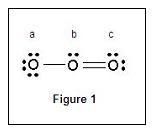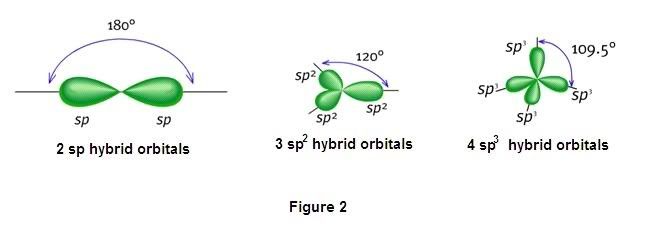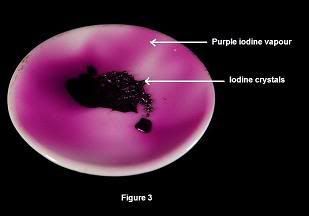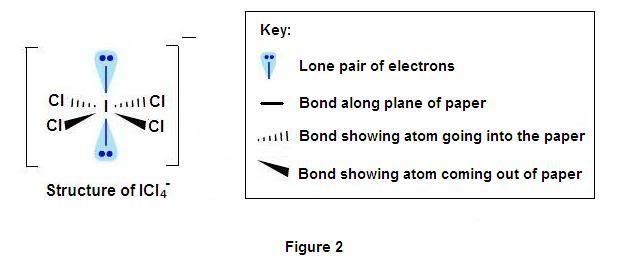Chemistry Questions
-
Hi... I need some help regarding about these few Chemistry questions...
I will appreciate any help.. really.
Question 1


Q1a) Based on the Lewis structure of ozone shown in Figure 1, explain if the distance between oxygen atom 'a' and oxygen atom 'b' is likey to be the same as the distance between oxygen atom 'b' and oxygen atom 'c' [4 marks]
Q1b) Lewis strucutre do not indicate the shapes of molecules. The Lewis structure of ozone is depicted as a linear (flat) molecule in Figure 1. Explain if this shape is likely to be accurate. [5 marks]
Q1c) With reference to Figure 2, deduce how each of the oxygen atom 'a', 'b', and 'c' of the ozone molecule shown in Figure 1 are hybridized. Explain your answer. [5 marks]
Question 2Iodine crystals can change directly to gaseous state (sublime) at room temperature and pressure(rtp). Figure 3 shows how solid iodine sublimes to purple vapour when left for some time on an evaporating dish.

Q2) Describe and explain what would be observed if a spoonful of iodine crystals was placed in a sealed air-tight container at rtp, and left untouched over a long period of time. [5 marks]
Question 3
The ion ICl4- has a square planar geometry as shown in Figure 2.


Q3) Explain why ICl4- does not adopt either of the structures, A and B, as shown in Figure 3. [4 marks]
-
Hello Darkness_hacker99

1a)
Based on the Lewis structure given, which is a single resonance contributor, clearly the double bond will have a smaller bond length than the single bond. However, in the actual structure (ie. taking in consideration all possible resonance contributors), each bond is one and a half, or partial double bond character, and are equivalent. Hence, the distance between oxygen atom 'a' and oxygen atom 'b' is EXACTLY the same as the distance between oxygen atom 'b' and oxygen atom 'c'.
Q1b)
The structure or molecular geometry of ozone is bent or v-shape or non-linear. The central atom forms an sp2 hybridization with one lone pair. (Since there are 3 electron clouds (in which the double bond is considered a single electron cloud), the electron geometry is trigonal planar, hence it is sp2 hybridized. The molecular geometry (in which we distinguish between lone pairs and bond pairs, is bent or v-shape or non-linear). The actual O-O-O angle has been shown by experimental evidence to be 116.78°.
Q1c)
Based on my explanation above in 1b), ie. considering the electron geometries, we see that :
a - tetrahedral, sp3 hybridized.
b - trigonal planar, sp2 hybridized.
c - trigonal planar, sp2 hybridized.
Again, be aware that this is just a single resonance contributor, and not the actual or real structure, hybridization or geometry.
Q2)
This question is worth 5 marks, which is odd (not odd number odd, but wierd odd). The question doesn't specify clearly what it requires of the student, but merely a "describe and explain" which is a generic instruction usually not worth 5 marks.
Anyways, iodine exists as in equilibrium between its solid and gas phases. What is little known is that iodine can and does exist in the liquid state (it's melting point is 386.85 K and its boiling point is 457.4 K), but indeed as the question correctly states, iodine will naturally sublimate at rtp (just as some water molecules would also sublimate from ice to gaseous water vapour, although most would transit into the liquid state; the difference between the behavour of iodine vs water is simply because the magnitude difference between the mp and bp of iodine is much smaller than for water).
I2 (s) ---> I2 (g)
Left untouched and over a long period of time in a closed system (ie. sealed air-tight container), some of the I2(s) would sublimate into I2(g). But since we're talking about equilibrium, and at r.t.p, you would still observe some solid iodine crystals (ie. not all of the solid would sublimate into gaseous iodine), no matter how long you wait. In other words, once equilibrium is reached between the solid and gaseous states, you will get a fixed, specific ratio of products (ie. gaseous iodine) to reactants (ie. solid iodine).
If it were an open system (ie. unsealed, open container), the solid crystals gradually disappear, and eventually so does the purple iodine vapour.
In this closed system (ie. airtight sealed container) an equilibrium has established. The equilibrium is between the iodine solid and the iodine vapour. It is called dynamic equilibrium because it is not static, both foward and backward reactions are occurring simultaneously, but at the same rate. What is happening is that I2 molecules are leaving the solid and entering the vapour phase at the same rate as they are leaving the vapour and entering the solid state. The forward and reverse rates have become the same and the system is at equilibrium. However, this is not a chemical equilibrium but a physical phase equilibrium.
Q3.
It has to do with the different (electronic and thermodynamic) stabilities of the various configurations or structures. Recall that lone pair - lone pair repulsion is greater than lone pair - bond pair repulsion is greater than bond pair - bond pair repulsion.
In structures A and B, the lone pairs are placed beside each other, which leads to structural instability due to a disparity in electron pair repulsions (ie. the lone pairs have greatest repulsion against each other and want to be placed or directed as far away from each other as possible). The most stable structure, both theoretically and from experimental evidence, would be the the square planar geometry as shown in Figure 2.

-
Thanks a lot!! =D The explanations are very clear and I finally understand le...! Thx!!
